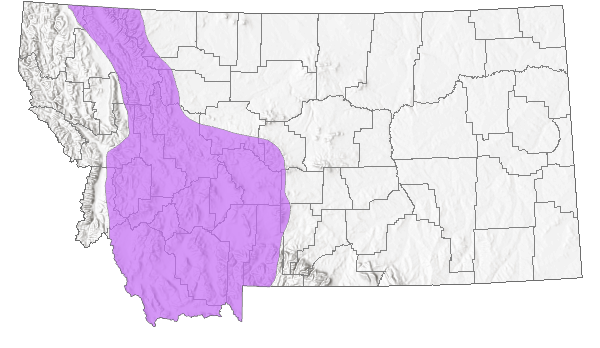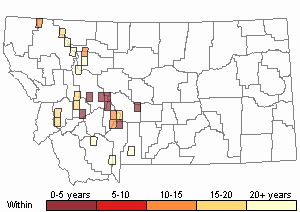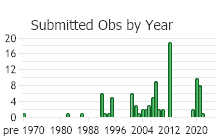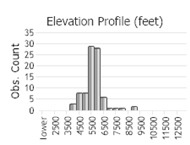View in other NatureServe Network Field Guides
NatureServe
Montana
Utah
Wyoming
Idaho
Wisconsin
British Columbia
South Carolina
Yukon
California
New York
Austin's Knotweed - Polygonum austiniae
Other Names:
Polygonum douglasii ssp. austiniae
State Rank Reason (see State Rank above)
Austin's knotweed is sparsely distributed in mountainous areas of Montana from the Rocky Mountain Front to the Madison and Gallatin Ranges. Sites are usually on open, gravelly, sparsely-vegetated slopes with shale-derived soils and as such are not generally impacted by human activity. Some sites however, are along forest roads and are susceptible to weed invasion and other disturbances. The probability of finding additional occurrences appears to be good since large areas of suitable habitat across western and central Montana remain unsurveyed for the species.
- Details on Status Ranking and Review
Population Size
Score1 - Moderate: Generally 10,000-100,000 individuals.
CommentPopulation size likely fluctuates widely from year to year depending upon growing conditions as the species is an annual.
Range Extent
Score0 - Widespread species within Montana (occurs in 5% or more of the state or generally occurring in 6 or more sub-basins.) as well as outside of Montana.
Area of Occupancy
Score1 - Moderate: Generally occurring in 11-25 Subwatersheds (6th Code HUC’s).
Environmental Specificity
Score1 - Moderate: Species is restricted to a specific habitat that is more widely distributed or to several restricted habitats and is typically dependent upon relatively unaltered, good-quality habitat (C Values of 5-7).
Trends
Score0-1 - Stable to Minor Declines:
CommentTrends are undocumented though the habitat is largely intact and stable and it does not appear likely that significant declines have or will occur in the near future.
Threats
Score1 - Medium: 11-30% of the populations are being negatively impacted or are likely to be impacted by one or more activities or agents, which are expected to result in decreased populations and/or habitat quality and/or quantity.
CommentInvasive species such as cheatgrass and knapweed are or have the potential to negatively impact a few of the populations.
Intrinsic Vulnerability
Score1 - Moderate Vulnerability: Specific biological attributes, unusual life history characteristics or limited reproductive potential makes the species susceptible to extirpation from stochastic events or other adverse impacts to its habitat and slow to recover.
CommentAnnual; seed banking potential is unknown.
Raw Conservation Status Score
Score
5 to 6 total points scored out of a possible 19.
General Description
Austin's Knotweed is a sparsely hairy annual with erect stems that are 3-10 cm high and branched near their bases. The alternate, narrowly egg-shaped to elliptic leaves are 5-15 mm long and 1/2-1/3 as wide. The lower leaves have short petioles, while the upper leaves are sessile and smaller. There are small membranous sheaths, or stipules, surrounding the stem at the point of leaf attachment. Groups of 1-4 tiny, nodding flowers occur in the axils of all but the lowest leaves. Each flower has 5-8 stamens and 5 petal-like tepals that are 2-3 mm long and green with white or pink margins. The shiny black achenes are 3-sided and mostly 2-2.5 mm long.
Phenology
Generally flowering in July and fruiting in August.
Diagnostic Characteristics
There are many similar-appearing annual species of Polygonum. The typical P. douglasii subsp. douglasii has leaves that are less than 1/3 as wide as they are long and achenes that are about 3 mm long. Many other species of Polygonum have erect flowers. A technical key and hand lens may be required for positive determination.
Species Range
Montana Range
Range Descriptions

 Native
Native
Range Comments
BC, AB south to CA, NV and WY (Lesica et al. 2012. Manual of Montana Vascular Plants. BRIT Press. Fort Worth, TX).
Observations in Montana Natural Heritage Program Database
Number of Observations: 91
(Click on the following maps and charts to see full sized version)
Map Help and Descriptions
Relative Density

Recency



 (Observations spanning multiple months or years are excluded from time charts)
(Observations spanning multiple months or years are excluded from time charts)
Habitat
Gravelly, often shale-derived soil of open slopes and banks in the montane zone.
Ecological Systems Associated with this Species
Ecology
POLLINATORS The following animal species have been reported as pollinators of this plant species or its genus where their geographic ranges overlap:
Bombus bifarius,
Bombus flavifrons,
Bombus frigidus,
Bombus melanopygus,
Bombus sylvicola,
Bombus occidentalis,
Bombus pensylvanicus,
Bombus insularis, and
Bombus kirbiellus (Macior 1974, Colla and Dumesh 2010).
References
- Literature Cited AboveLegend:
 View Online Publication
View Online Publication Colla, S.R. and S. Dumesh. 2010. The bumble bees of southern Ontario: notes on natural history and distribution. Journal of the Entomological Society of Ontario 141:39-68.
Colla, S.R. and S. Dumesh. 2010. The bumble bees of southern Ontario: notes on natural history and distribution. Journal of the Entomological Society of Ontario 141:39-68. Lesica, P., M.T. Lavin, and P.F. Stickney. 2012. Manual of Montana Vascular Plants. Fort Worth, TX: BRIT Press. viii + 771 p.
Lesica, P., M.T. Lavin, and P.F. Stickney. 2012. Manual of Montana Vascular Plants. Fort Worth, TX: BRIT Press. viii + 771 p. Macior, L.M. 1974. Pollination ecology of the Front Range of the Colorado Rocky Mountains. Melanderia 15: 1-59.
Macior, L.M. 1974. Pollination ecology of the Front Range of the Colorado Rocky Mountains. Melanderia 15: 1-59.
- Additional ReferencesLegend:
 View Online Publication
View Online Publication
Do you know of a citation we're missing? Lesica, P., M.T. Lavin, and P.F. Stickney. 2022. Manual of Montana Vascular Plants, Second Edition. Fort Worth, TX: BRIT Press. viii + 779 p.
Lesica, P., M.T. Lavin, and P.F. Stickney. 2022. Manual of Montana Vascular Plants, Second Edition. Fort Worth, TX: BRIT Press. viii + 779 p. Poole, J.M. and B.L. Heidel. 1993. Sensitive plant surveys in the Big Belt and Elkhorn Mountains, Helena National Forest, Montana. Unpublished report to the Helena National Forest. Montana Natural Heritage Program. Helena, MT. 129 pp. plus printouts, maps.
Poole, J.M. and B.L. Heidel. 1993. Sensitive plant surveys in the Big Belt and Elkhorn Mountains, Helena National Forest, Montana. Unpublished report to the Helena National Forest. Montana Natural Heritage Program. Helena, MT. 129 pp. plus printouts, maps. Vanderhorst, J.P. and B.L. Heidel. 1995. Sensitive plant survey in the Tobacco Root Mountains, Madison County, Montana. Unpublished report to the Beaverhead and Deerlodge National Forests. Montana Natural Heritage Program. Helena, MT. 66 pp. plus appendices.
Vanderhorst, J.P. and B.L. Heidel. 1995. Sensitive plant survey in the Tobacco Root Mountains, Madison County, Montana. Unpublished report to the Beaverhead and Deerlodge National Forests. Montana Natural Heritage Program. Helena, MT. 66 pp. plus appendices.
- Web Search Engines for Articles on "Austin's Knotweed"





